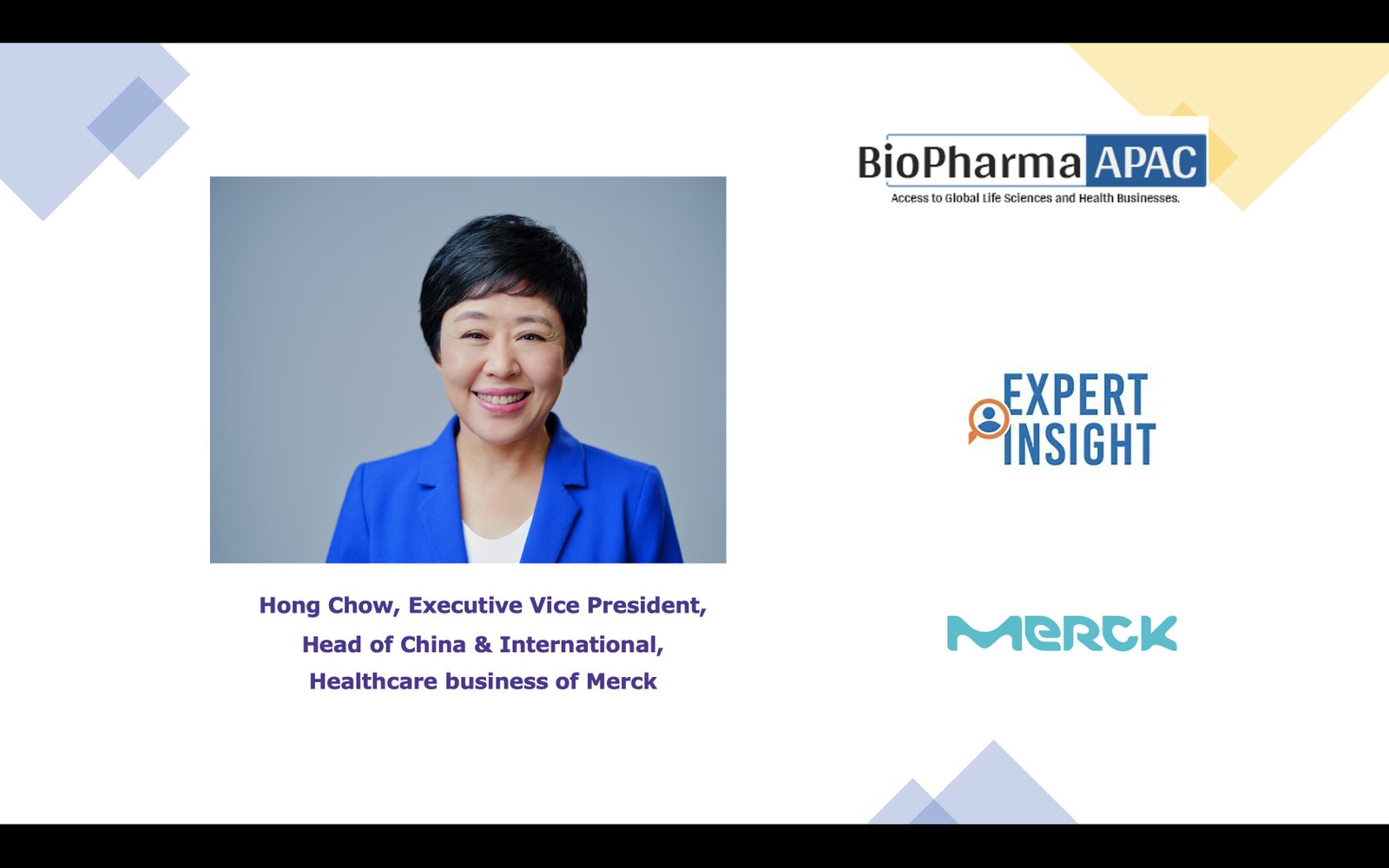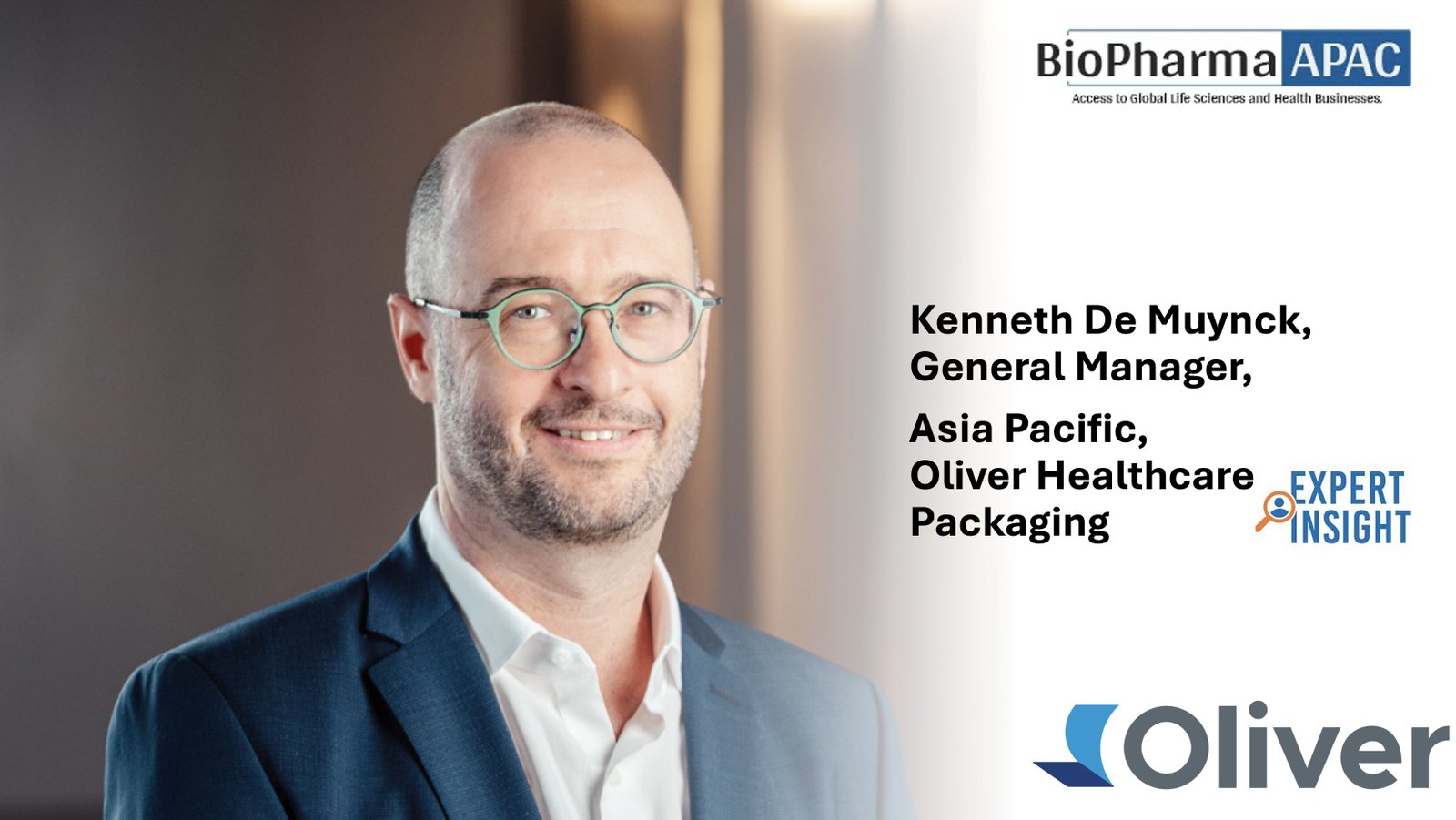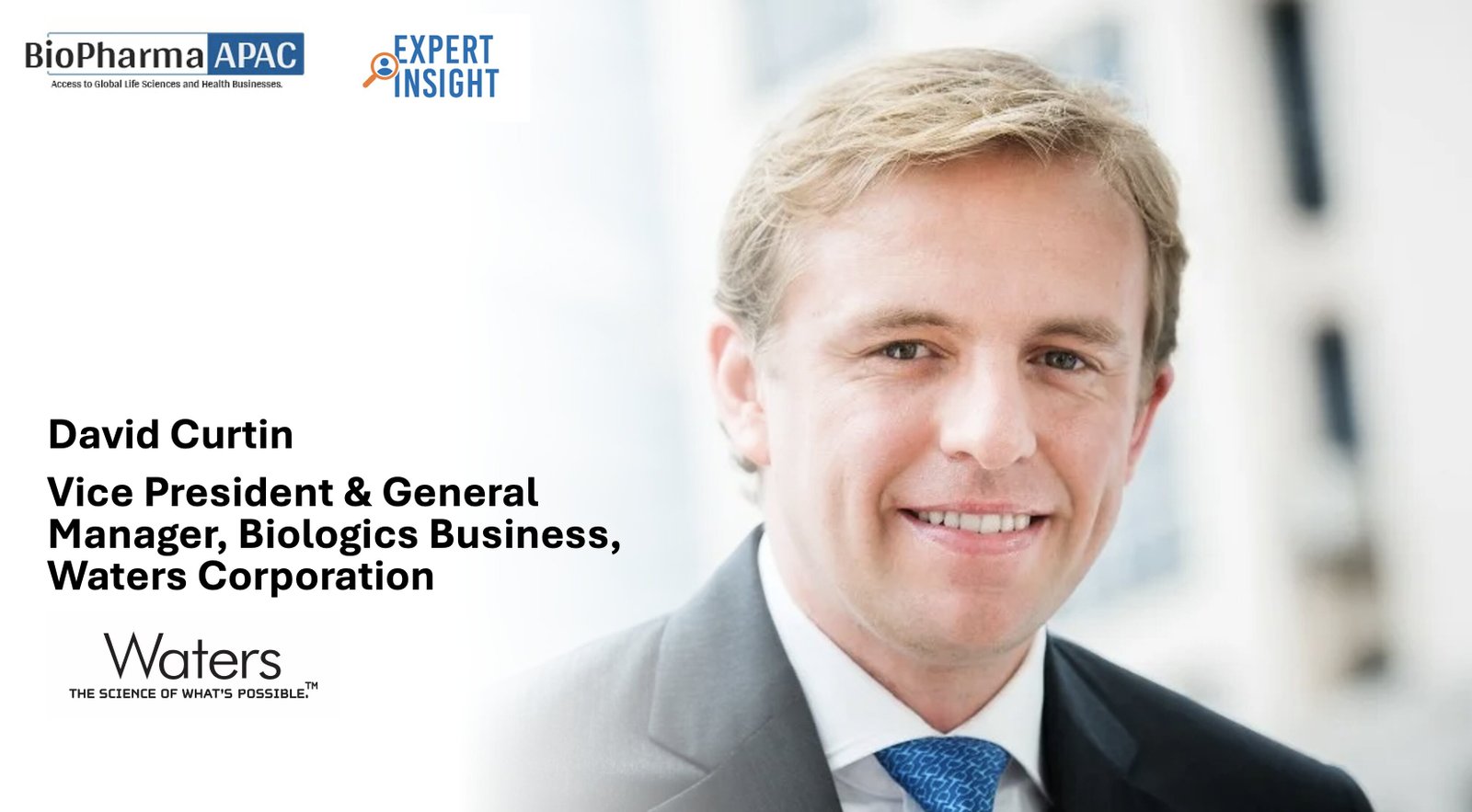Hong Chow discusses Merck's ambitious €25 billion sales goal, sustainability initiatives, innovation priorities, and fostering a high-impact culture in the Asia-Pacific region
14 November 2023 | Tuesday | News

Hong Chow, Executive Vice President, Head of China & International, Healthcare Business of Merck
In an exclusive interview by BioPharma APAC , Hong Chow, Executive Vice President and Head of China & International for Merck's Healthcare business, provides valuable insights into Merck's strategic initiatives in the Asia-Pacific (APAC) region. From achieving ambitious sales targets to integrating sustainability into core operations, driving innovation, fostering a high-impact culture, and forming successful alliances, Hong Chow sheds light on Merck's commitment to addressing the unique healthcare needs and opportunities within the diverse markets of the APAC region.
Merck has set an ambitious goal of achieving €25 billion in Group sales by 2025. Can you share some insights into the key strategies and initiatives that will drive this growth in the Asia-Pacific region, given its significance in the pharmaceutical and biotech sectors?
All teams in the Healthcare business sector of Merck are united as one for patients to help create, improve and prolong lives. The APAC region, including China, plays a large role in realizing our purpose as well as our Healthcare growth story to achieve the company’s overarching goal of €25 billion sales by 2025. Some of our most important markets are in this region and we have many opportunities to leverage and have focused our commitments by making the right investments, too. As part of our Healthcare strategy, the emerging markets and China are expected to be the largest growth drivers for many of our established products in the future.
In the third quarter of this year, almost 29% of the Healthcare business’s net sales came out of APAC. We see strong growth driven by our innovative medicines in developed markets like Japan and Australia, and also with our established portfolio in emerging markets such as Vietnam, South Korea and India.
To deliver on our ambition of €25 billion by 2025, we focus on the following specific growth drivers in the APAC region:
- As we see the number of cancer patients rising in APAC, there is a continued need for patients to have access to effective cancer treatments. Therefore, we see strong short- and mid-term growth for our treatment options for patients with metastatic bladder cancer, colorectal, head and neck, or lung cancer.
- As a global leader in Fertility, our end-to-end drug portfolio provides treatment solutions for all phases of the in vitro fertilization procedures. As we see countries like Korea, China and Japan struggling with declining birth rates, we collaborate with policy makers and health institutions to raise the awareness and provide the right solutions to improve the patient experience along the treatment journey.
- In our Cardiovascular, Metabolism and Endocrinology business, we are addressing the high need in the region with our medicines, leading the fight against pressing health issues in APAC such as diabetes, hypertension and thyroid disorders and providing widespread access to affordable, best-in-class solutions.
- And with more than 20 years of experience in multiple sclerosis care, we remain committed to finding solutions for chronic progressive diseases.
Merck has emphasized the importance of sustainability. How is Merck Group working to integrate sustainability into its core operations, and what role does the APAC region play in these efforts, especially with regard to environmental and social impact?
Merck knows sustainability is a journey, not a destination. Which is why our Group-wide Sustainability Strategy makes three ambitious commitments:
- Dedicated to human progress: By 2030, we will advance human progress for >1 billion people through sustainable science and technology.
- Creating sustainable value chains: By 2030, we will integrate sustainability into all our value chains.
- Reducing our ecological footprint: By 2040, we will achieve climate neutrality and reduce our resource consumption.
In order to reach our sustainability goals, we are concentrating on several focus areas in which we are pursuing numerous initiatives and projects. This ensures that we successfully implement our sustainability strategy, and that sustainability becomes a success factor across all our three business sectors and our regions globally.
APAC plays a crucial role for these efforts, and we are proud of the progress we already see. Let me give you some examples specifically on environmental and social impact:
- In 2022, we reduced our CO2 impact by 12% and shaved 750 tons of carbon off our distribution footprint in six APAC countries through our collaboration with our distribution partner, Zuellig Pharma. This is equivalent to 840,000 pounds of coal burned or almost 2 million miles driven by an average passenger vehicle.
- By 2030, we aim to improve healthcare access for 80 million patients in low and middle-income countries across the globe every year, this includes countries in the APAC region. Our access strategy is based on the principles of going deeper, wider and faster. For example, in India, our primary focus centers on a sustainable initiative in the field of Oncology known as "Umeed," which translates to "HOPE”. This project encompasses a comprehensive approach, with targeted interventions across the entire spectrum of the patient journey. These initiatives range from awareness and prevention campaigns to early diagnosis efforts.
- One initiative we have launched in APAC is called “Fertility Counts” with which we aim to address the social, economic and societal challenges associated with low birth rates in APAC. This initiative provides research and resources to help policymakers build family-friendly societies.
- We are the founding private sector partner of Healthy Women, Healthy Economies, an initiative led by Asia-Pacific Economic Cooperation (APEC) that looks at how to advance women’s health and wellbeing for their economic empowerment.
- For Merck, building a truly inclusive organization that reflects the diversity of our modern world is a competitive advantage and a business priority. With strong performance and future growth predicted not only in Asia, but also Latin America, the Middle East and Africa, we aim to increase the global share of employees in leadership positions from these regions from 16% today to 30% by 2030. Within the Commercial team that I am leading, we already have 42% women in leadership roles in APAC and even 67% women in General Manager roles.
Merck has a strong focus on innovation. Could you elaborate on the company's innovation priorities for the Asia-Pacific region and how these align with Merck's global innovation strategy?
With more than 350-years of history, Merck naturally ingrains strong heritage and principles, but yet also the need to constantly challenge ourselves and pursue innovation not only for our products but also how we lead our business. The APAC region mainly plays two roles within our innovation efforts:
- Inclusion of Asia in clinical trials: As we see high unmet medical needs and a large patient population in APAC, for example in cancers like head and neck, it is important to enroll more patients in clinical trials. Currently, we are highly committed with a significant number of sites in key APAC countries that are engaged in global and local clinical studies.
- Source of innovation: We have important Research & Development centers in Bangalore, Tokyo and Beijing, fully connected to our global innovation network. And we are investing in the region, for example in our R&D Excellence Centre in Bangalore which shall become a Global R&D Hub with up to 400-600 employees by 2025. Additionally, APAC play an important role regarding strategic partnerships. An excellent example for collaboration and partnerships in APAC is the recently announced strategic partnership with Jiangsu Hengrui Pharmaceuticals Co. Ltd to strengthen our Oncology pipeline.
One of your key priorities is creating a high-impact culture within the organization. How are you fostering a culture of excellence and collaboration in the APAC region, and what challenges have you encountered in doing so?
By 2030, we will have advanced human progress for more than 1 billion people through sustainable science & technology. To truly realize this vision, we need to focus on our people – their talent, their performance and their ideas, to unleash the potential of science as a force for good. We’ve chosen to accelerate this change through a high-impact culture built on the principles of Caring, Pioneering and Outperforming.
We empower our local leaders to serve as cultural ambassadors and ensure that the company's values are upheld while respecting local customs. Acknowledging and respecting the cultural diversity in the APAC region is key. We celebrate local festivals, traditions, and customs, making employees feel valued and understood.
When it comes to challenges, I would say we are facing common challenges which come with change. One of our high-impact culture behaviors is to disagree openly, decide and deliver (3Ds). To achieve this, an inclusive environment is fundamental. We can ask our teams to follow the 3Ds, yet we as leaders need to create the environment that allows to disagree openly and include different perspectives in decision making.
In general, we want to create an environment where our employees can bring their whole self to work. For me, Diversity, Equity and Inclusion is not a “nice to have” , it is a decisive factor for being able to attract the right talent, investors, partners, customers and gain access to markets overall.
Merck's global alliances have been instrumental in enhancing the value of the Healthcare portfolio. Can you provide examples of strategic alliances or partnerships that have been particularly successful in the APAC region and their impact on Merck's business?
There are many great partnerships and collaborations with government bodies or local associations, but let me highlight two:
- In Indonesia, together with the Indonesian Ministry of Health, the medical associations Indonesia Thyroid Association (INATA) and Indonesia Doctor Association (IDI), we have established the RAISE Thyroid Program which aims to we aim to reach 52,000 health workers, conduct screenings in 7,000 health facilities, and screen three million high-risk adults. Since May this year, more than 2,600 healthcare professionals have been trained on thyroid screening and more than 19,200 patients were screened.
- In Vietnam, we have signed a strategic cooperation agreement with pharmacy chains to improve the capacity of pharmacists in community health care in two main activities, including improving knowledge and consulting skills for pharmacists and raising awareness for patients about cardiovascular diseases, diabetes, and thyroid diseases. The program is part of a series of strategic activities of Merck Healthcare Vietnam to improve the consulting skills and quality of community pharmacists, thereby making an important contribution to ensuring the healthcare quality for Vietnamese people.
In your role, what is Merck Group's stance on addressing the unique healthcare needs and opportunities presented by the diverse markets within the Asia-Pacific region, including countries with varying levels of development and healthcare infrastructure?
Our approach to addressing the unique healthcare needs and opportunities within the diverse markets of the Asia-Pacific region is rooted in harnessing the region's unique strengths while navigating its challenging landscapes. We recognize the remarkable diversity within the Asia-Pacific region, encompassing countries with varying levels of development and healthcare infrastructure. This diversity is not a hindrance but a wellspring of opportunities. Our stance is to harness these unique strengths and tailor our strategies accordingly.
In developed markets, we emphasize innovation and advanced healthcare solutions to meet the growing demands of increasingly sophisticated healthcare challenges. Here, our focus is on collaboration with local healthcare providers, academic institutions, and research centers to bring cutting-edge therapies and technologies to patients.
In contrast, in less developed regions, our commitment lies in bridging the healthcare gap. Providing access to health in the low- and middle- income countries is a complex challenge. Improving access involves researching, developing, and refining health solutions, creating efficient health systems and distribution channels, offering products at affordable prices and empowering health workers and patients.
Regulatory complexities, cultural nuances, and variations in healthcare policies demand a tailored approach for each country. Our dedication to fostering collaboration with local governments, non-profit organizations, and community leaders is a cornerstone of our strategy.
We believe that by tailoring our approach, nurturing local collaborations, and staying committed to our purpose of As One for Patients and mission of advancing healthcare, we can make a meaningful impact and contribute to better patient outcomes throughout the region.
arcilla.fran@biopharmaapac.com
Most Read
- Top 25 Biotech & Biopharma Leaders in Sustainable Innovation, 2025
- China’s Biopharma Dealmaking Surges in H1 2025, Driven by Record Licensing and Oncology Focus
- Chikungunya in China: How a “Forgotten” Arbovirus Found the Perfect Storm
- How Innovation Gaps in Biopharma Raise New Safety Concerns
- Smart Implants and the Future of Musculoskeletal Injury Treatment
- How Ethical Gaps in Psychiatry Could Undermine Biopharma Progress
- The Evolving Landscape of Women’s Health Innovation in the Asia-Pacific
- Using NLP-Driven Decision Support in Emergency Health Assistance
- Taiwan Steps Into the Global Spotlight With a New Cancer Therapy
- The Role of Unique Device Identification (UDI) in Tracing Medical Device Safety
- The Importance of a Patient’s Mental Health During Clinical Trials
Bio Jobs
- The State of Biotech and Life Science Jobs in Asia Pacific – 2025
- Avantor’s New CEO Ligner Aims to Unlock Global Potential and Deliver Shareholder Value
- AstraZeneca Commits $50 Billion to U.S. Expansion by 2030 in Biggest-Ever Global Investment
- Thermo Fisher, SAMRC, and South Africa’s Department of Science and Innovation Launch CATIR to Nurture Next-Gen Scientists
- Cube Biotech Appoints Former Sartorius CEO Dr. Joachim Kreuzburg to Board of Directors
- FDA’s AI Transition Marks a Turning Point in Drug Review: Industry Faces Pressure to Adapt Amid 20% Workforce Cut
- WuXi XDC Completes Mechanical Build of Singapore Bioconjugate Manufacturing Hub
News
Editor Picks











